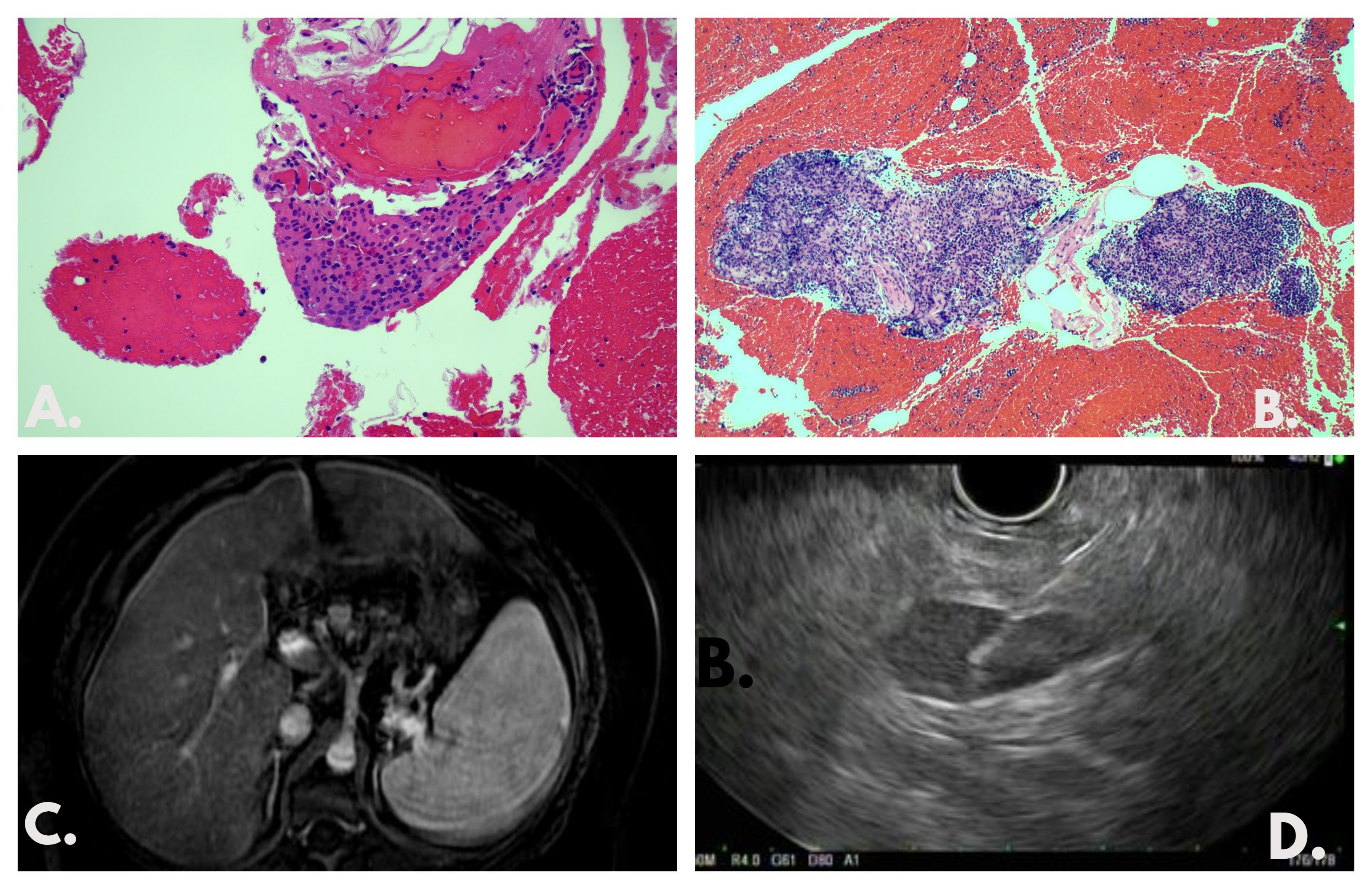Back
Poster Session E - Tuesday Afternoon
E0040 - Tertiary Lymphoid Structure Mimicking Pancreatic Mass
Tuesday, October 25, 2022
3:00 PM – 5:00 PM ET
Location: Crown Ballroom

Marcel R. Robles, MD
Tufts University School of Medicine, St. Elizabeth's Medical Center
Boston, MA
Presenting Author(s)
Marcel R. Robles, MD1, Michael Malkowski, MD1, Sandeep Krishnan, MBBS, PhD2
1Tufts University School of Medicine, St. Elizabeth's Medical Center, Boston, MA; 2St. Elizabeth's Medical Center, Tufts University School of Medicine, Brighton, MA
Introduction: Tertiary lymphoid structures (TLS) are defined as non-congenital ectopic lymphoid tissues that can be found in non-lymphoid organs and form in response to chronic inflammation. TLS’s etiology as well as it’s physiological and pathological roles remain a highly debated topic.
Case Description/Methods: An asymptomatic 50-year-old obese diabetic female with a history of biopsy proven cirrhosis secondary to non-alcoholic fatty liver disease (NAFLD) presented to the clinic after a routine hepatocellular carcinoma (HCC) surveillance MRI. A 1.3 cm enhancing nodule at the neck of pancreas was noted. Due to concern for pancreatic cancer an endoscopic ultrasound with fine needle biopsy (EUS-FNB) was planned. During EUS an 11.4 mm by 8.5mm oval mass with irregular margins was identified in the pancreatic body. Fine needle biopsy with 22-gauge needle was performed using trans gastric approach. An enlarged lymph node was identified in peripancreatic region measuring 24.2 mm by 10.9 mm, an additional fine needle biopsy was obtained. Pathology of pancreatic mass and lymph node later revealed fragments of lymphoid tissue consistent with reactive lymph node with single cluster of cytologically mildly atypical cells however no evidence of metastatic malignancy was appreciated. Immunohistochemical staining was positive for CD3 and CD20. CD56, chromogranin, synaptophysin, CD10, e-cadherin and AMACR stains were negative. Flow cytometry analysis was ordered. It demonstrated no evidence of a lymphoproliferative disorder. A three-month post procedure MRI was obtained which demonstrated a 1.6 cm nodule at neck of the pancreas increased in size when compared to prior image.
Discussion: In immunology, TLS are a highly debated topic as to whether they serve as mediators of protective or pathologic immune responses in certain chronic inflammatory diseases and in the regulation of immune responses. When associated with both primary and or metastatic tumors they’re known as tumor-associated TLS (TA-TLS). In cancer their presence is associated with prolonged increased rates of disease-free survival. When identified flow cytometry should always be ordered in order to rule out a lymphoproliferative disorder. TLS and its implications are still an area of active study, clear guidelines in terms of management are still being developed. Furthermore as to whether they represent premalignant lesion is still unknown. Our patient remains asymptomatic and continues to be monitored with serial imaging.

Disclosures:
Marcel R. Robles, MD1, Michael Malkowski, MD1, Sandeep Krishnan, MBBS, PhD2. E0040 - Tertiary Lymphoid Structure Mimicking Pancreatic Mass, ACG 2022 Annual Scientific Meeting Abstracts. Charlotte, NC: American College of Gastroenterology.
1Tufts University School of Medicine, St. Elizabeth's Medical Center, Boston, MA; 2St. Elizabeth's Medical Center, Tufts University School of Medicine, Brighton, MA
Introduction: Tertiary lymphoid structures (TLS) are defined as non-congenital ectopic lymphoid tissues that can be found in non-lymphoid organs and form in response to chronic inflammation. TLS’s etiology as well as it’s physiological and pathological roles remain a highly debated topic.
Case Description/Methods: An asymptomatic 50-year-old obese diabetic female with a history of biopsy proven cirrhosis secondary to non-alcoholic fatty liver disease (NAFLD) presented to the clinic after a routine hepatocellular carcinoma (HCC) surveillance MRI. A 1.3 cm enhancing nodule at the neck of pancreas was noted. Due to concern for pancreatic cancer an endoscopic ultrasound with fine needle biopsy (EUS-FNB) was planned. During EUS an 11.4 mm by 8.5mm oval mass with irregular margins was identified in the pancreatic body. Fine needle biopsy with 22-gauge needle was performed using trans gastric approach. An enlarged lymph node was identified in peripancreatic region measuring 24.2 mm by 10.9 mm, an additional fine needle biopsy was obtained. Pathology of pancreatic mass and lymph node later revealed fragments of lymphoid tissue consistent with reactive lymph node with single cluster of cytologically mildly atypical cells however no evidence of metastatic malignancy was appreciated. Immunohistochemical staining was positive for CD3 and CD20. CD56, chromogranin, synaptophysin, CD10, e-cadherin and AMACR stains were negative. Flow cytometry analysis was ordered. It demonstrated no evidence of a lymphoproliferative disorder. A three-month post procedure MRI was obtained which demonstrated a 1.6 cm nodule at neck of the pancreas increased in size when compared to prior image.
Discussion: In immunology, TLS are a highly debated topic as to whether they serve as mediators of protective or pathologic immune responses in certain chronic inflammatory diseases and in the regulation of immune responses. When associated with both primary and or metastatic tumors they’re known as tumor-associated TLS (TA-TLS). In cancer their presence is associated with prolonged increased rates of disease-free survival. When identified flow cytometry should always be ordered in order to rule out a lymphoproliferative disorder. TLS and its implications are still an area of active study, clear guidelines in terms of management are still being developed. Furthermore as to whether they represent premalignant lesion is still unknown. Our patient remains asymptomatic and continues to be monitored with serial imaging.

Figure: A. Magnification 200x. Small fragment of benign pancreatic acinar cells near lymphoid cluster. B. Magnification 100x. Aggregates of lymphoid tissue with intervening capillaries representing lymph node like structure within pancreas. C. MRI Abdomen with contrast showing 1.3 cm enhancing nodule at neck of pancreas. D. EUS. Fine needle aspiration of 11.4 mm by 8.5 mm intrapancreatic mass .
Disclosures:
Marcel Robles indicated no relevant financial relationships.
Michael Malkowski indicated no relevant financial relationships.
Sandeep Krishnan indicated no relevant financial relationships.
Marcel R. Robles, MD1, Michael Malkowski, MD1, Sandeep Krishnan, MBBS, PhD2. E0040 - Tertiary Lymphoid Structure Mimicking Pancreatic Mass, ACG 2022 Annual Scientific Meeting Abstracts. Charlotte, NC: American College of Gastroenterology.
